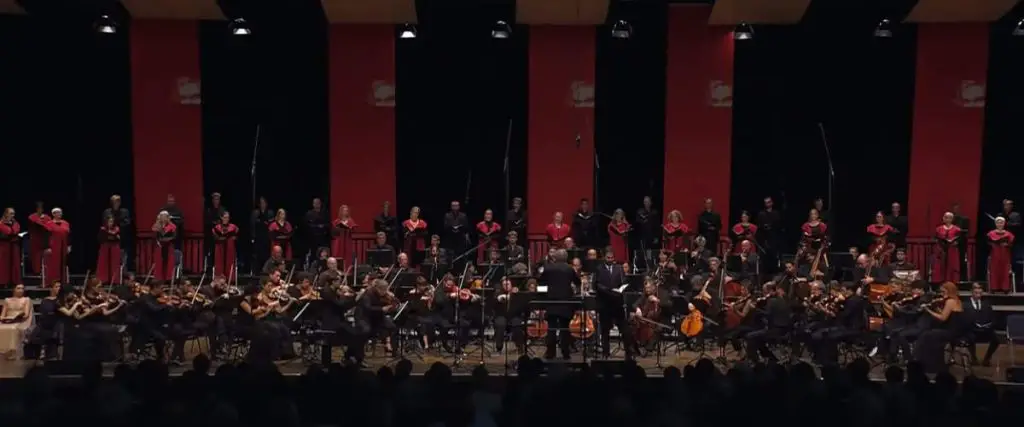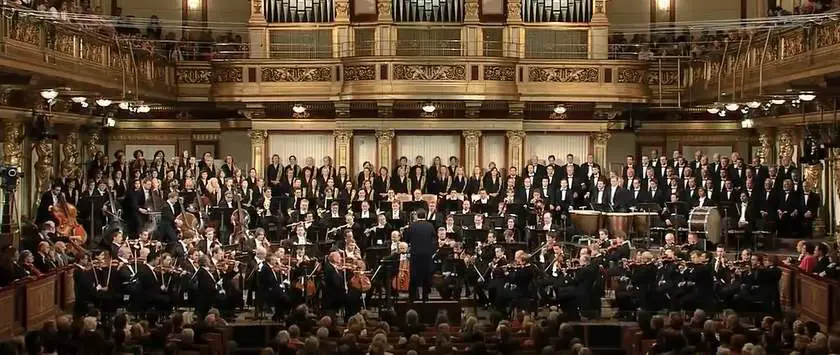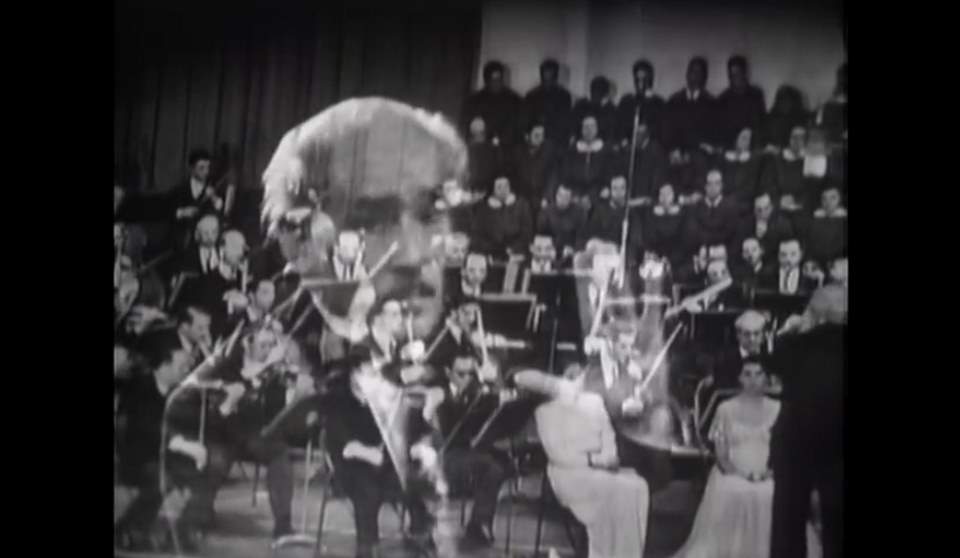Conducted by Klaus Mäkelä, the Oslo Philharmonic Orchestra and Choir perform Ludwig van Beethoven’s Symphony No. 9 in D minor, Op. 125. This performance was recorded in Oslo Concert Hall on January 4, 2019.
Soloists
- Lauren Fagan, soprano
- Hanna Hipp, mezzo soprano
- Tuomas Katajala, tenor
- Shenyang, bass-baritone
Beethoven’s Symphony No. 9
Ludwig van Beethoven’s Symphony No. 9 in D minor, Op. 125, stands as one of the most celebrated and profound compositions in Western music history. Completed in 1824, it was Beethoven’s final complete symphony and represents a monumental achievement in his musical career. The Ninth Symphony is particularly famous for its choral finale, a groundbreaking feature for symphonic form at the time, which includes Friedrich Schiller’s “Ode to Joy” – an ode to universal brotherhood, joy, and freedom.
Beethoven, who was almost completely deaf when he composed the symphony, broke new ground by integrating vocal and instrumental music into a symphony. The addition of a chorus and solo voices in the final movement was revolutionary and marked a significant departure from the traditional structure of symphonies that had been instrumental up to that point. The Ninth Symphony’s choral finale has since become one of the most recognizable pieces of Western classical music.
The symphony is noted for its complexity and emotional range. Throughout its four movements, it explores themes of struggle, joy, and triumph. Beethoven’s mastery of musical narrative is evident as he takes listeners on a journey from the darkness and tension of the first movements to the joyous and triumphant climax in the final movement.
The Ninth Symphony also exemplifies Beethoven’s innovation and influence in the realm of romanticism in music. His use of thematic development and the extensive length of the symphony were both novel at the time and showcased his ability to push the boundaries of symphonic form.
Since its premiere, Beethoven’s Ninth Symphony has been interpreted as a powerful symbol of freedom and unity. It has been performed at various significant events in history, including the fall of the Berlin Wall, symbolizing its enduring message of hope and brotherhood. The symphony’s “Ode to Joy” melody has also been adopted as the anthem of the European Union.
Movements
With start times in the video:
- Allegro ma non troppo, un poco maestoso 0:38
- Molto vivace 16:07
- Adagio molto e cantabile 30:20
- Presto – Allegro assai 43:52
1. Allegro ma non troppo, un poco maestoso
The first movement of Beethoven’s Symphony No. 9 in D minor, Op. 125, is a powerful and dramatic opening to this monumental work. Marked “Allegro ma non troppo, un poco maestoso” (Fast, but not too much, a little majestic), this movement sets the tone for the entire symphony with its intensity and complexity.
Opening with a mysterious and tense introduction, the movement quickly establishes a mood of conflict and struggle. This introduction features a series of dissonant chords that create a sense of unease and anticipation. The tension in this opening section gradually builds, leading into the main body of the movement.
The main theme of the first movement is forceful and assertive, characterized by its rhythmic drive and dramatic dynamics. Beethoven employs a sonata form for this movement, a common structure in classical symphonies, consisting of exposition, development, and recapitulation. However, his treatment of this form is innovative and expansive.
In the exposition, the main themes are introduced and explored. These themes are marked by their bold and dramatic character, reflecting the turbulent emotions that underpin the movement. Beethoven’s use of orchestration is masterful, with the full range of the orchestra being utilized to create a rich and powerful sound.
The development section sees Beethoven manipulating and transforming the themes introduced in the exposition. This part of the movement is characterized by its intensity and complexity, with the music exploring a wide range of emotions and ideas. The development builds to a climactic point, heightening the sense of conflict and drama.
The recapitulation brings back the main themes from the exposition, but now they are altered and intensified, reflecting the journey the music has undertaken. The movement concludes with a coda that reiterates the main themes, bringing the movement to a powerful and decisive close.

2. Molto vivace
The second movement of Beethoven’s Symphony No. 9 in D minor, Op. 125, contrasts sharply with the dramatic and tense first movement. This movement, marked “Molto vivace – Presto,” is known for its rhythmic vitality and spirited character. It follows a scherzo and trio structure, which was a common form in Beethoven’s symphonies, replacing the traditional minuet and trio format used in earlier symphonies.
The scherzo, which means “joke” in Italian, is anything but light in the context of this symphony. It is fast-paced, and energetic, and features a robust rhythmic motif that dominates the movement. This motif is introduced right at the beginning and is characterized by a rhythmic drive that propels the movement forward. The scherzo’s relentless pace and rhythmic intensity create a sense of urgency and excitement.
The orchestration in this movement is dynamic and bold. Beethoven uses the full orchestra to create a powerful sound, with the strings, brass, woodwinds, and percussion all contributing to the energetic atmosphere. The use of timpani is particularly notable, emphasizing the rhythmic drive of the movement.
Following the scherzo section is the trio, which provides a contrast to the intense energy of the scherzo. The trio is more lyrical and melodic, offering a moment of respite from the relentless pace. However, this is not to say that the trio is entirely calm; it still maintains a sense of movement and energy but in a more subdued manner.
After the trio, the scherzo returns, bringing back the energetic theme and driving rhythm. The movement then moves into a coda, which brings it to a rousing and emphatic conclusion. This coda reiterates the main themes and solidifies the movement’s spirited character.
3. Adagio molto e cantabile
The third movement of Beethoven’s Symphony No. 9 in D minor, Op. 125, is a profound departure from the vigorous energy of the second movement, offering a reflective and deeply emotive experience. This movement is an Adagio, marked “Adagio molto e cantabile,” which translates to “very slow and singing.” It is here that Beethoven explores the lyrical and serene aspects of his musical expression.
Characterized by its slow tempo and beautiful, expansive melodies, the third movement serves as a moment of introspection and calm in the symphony. The Adagio opens with a gentle and lyrical theme played by the strings, setting a mood of tranquility and contemplative beauty. This theme is developed and passed around different sections of the orchestra, each time adding new layers of emotional depth and complexity.
The structure of this movement is a double variation, where two contrasting themes are presented and then varied in turn. The first theme, as introduced, is serene and flowing, evoking a sense of peacefulness. The second theme, in contrast, is more expressive and passionate, yet still maintains the movement’s overall sense of calm and introspection.
Throughout this movement, Beethoven’s mastery in orchestration is evident. He uses the full range of the orchestra to create a rich tapestry of sound but does so in a way that is always delicate and controlled. The orchestration never overwhelms the gentle nature of the music, instead serving to enhance its emotional resonance.
One of the striking aspects of this Adagio is its sheer length and the way Beethoven sustains the emotional intensity throughout. The slow tempo and expansive development of themes allow for a deep exploration of emotional states, ranging from serene contemplation to deep longing.
As the movement draws to a close, the music gradually becomes more subdued, ending in a peaceful and reflective manner. This sets the stage for the dramatic and triumphant final movement of the symphony.
4. Presto – Allegro assai
The fourth movement of Beethoven’s Symphony No. 9 in D minor, Op. 125, is perhaps the most famous and groundbreaking part of this monumental work. It is in this final movement that Beethoven introduces the choral element, making an unprecedented and revolutionary move in symphonic music. The movement is widely known for its setting of Friedrich Schiller’s poem “Ode to Joy,” a celebration of universal brotherhood and the joy of human unity.
The movement begins with a dramatic introduction, where themes from the previous movements are recalled and then dismissed in favor of something new. This leads to the introduction of the famous “Ode to Joy” theme, initially played by the cellos and basses. This theme is simple, yet it carries a profound sense of humanity and optimism.
As the movement progresses, the “Ode to Joy” theme is developed and expanded. Beethoven brings in the solo vocalists and then the chorus, adding layers of complexity and richness to the music. The text of “Ode to Joy,” sung by the chorus, expresses a vision of a world united in joy and brotherhood, echoing the ideals of the Enlightenment and Beethoven’s own beliefs.
The orchestration in this movement is grand and expansive, matching the scale and ambition of the music. Beethoven uses the full forces of the orchestra, chorus, and soloists to create a sound that is both majestic and profoundly moving.
A particularly notable section is the “Turkish March,” where Beethoven introduces a more martial, percussive element to the music. This section adds contrast and variety to the movement, showcasing Beethoven’s skill in handling different musical styles.
The movement builds to a powerful and triumphant conclusion, with the full chorus and orchestra uniting to deliver the final, exultant lines of the poem. This ending is not just a musical climax, but a culmination of the work’s philosophical and humanistic themes.
Sources
- Symphony No. 9 (Beethoven) on Wikipedia
- Symphony No. 9 in D Minor, Op. 125 on the Encyclopedia Britannica website



